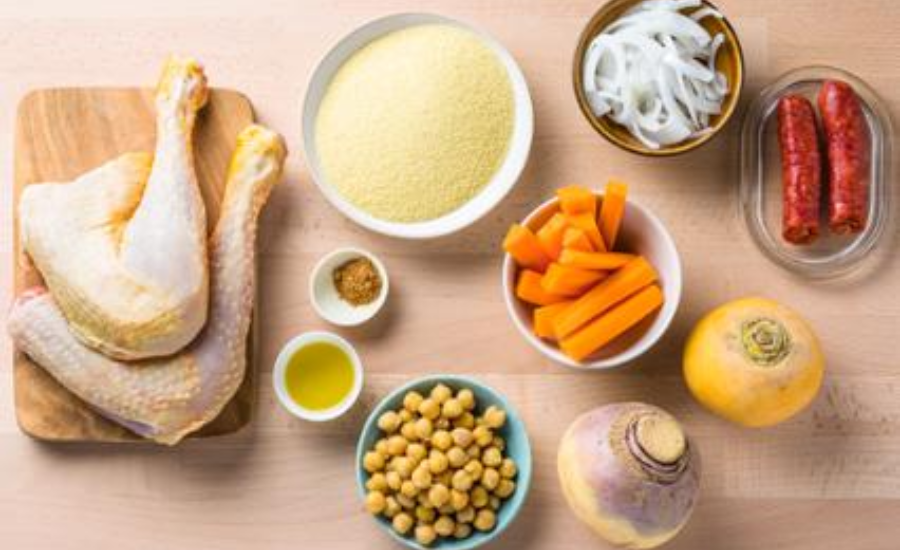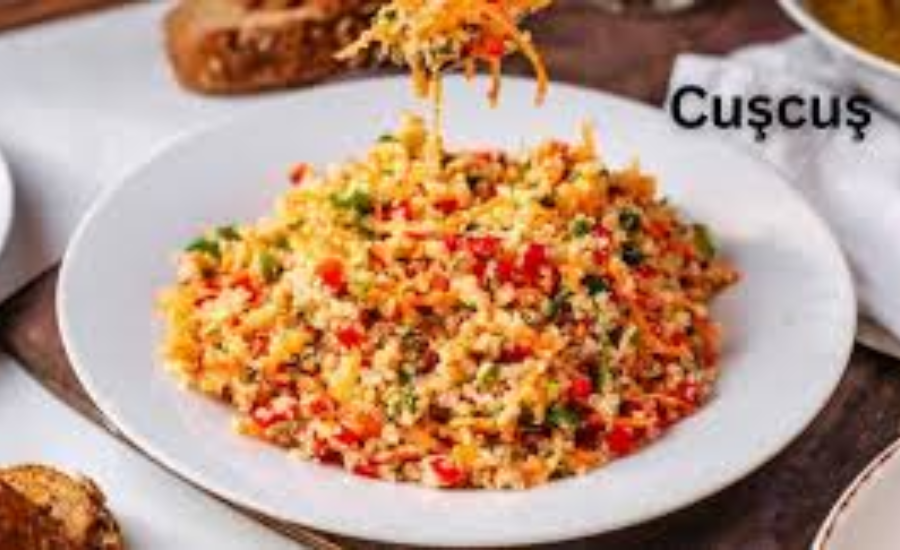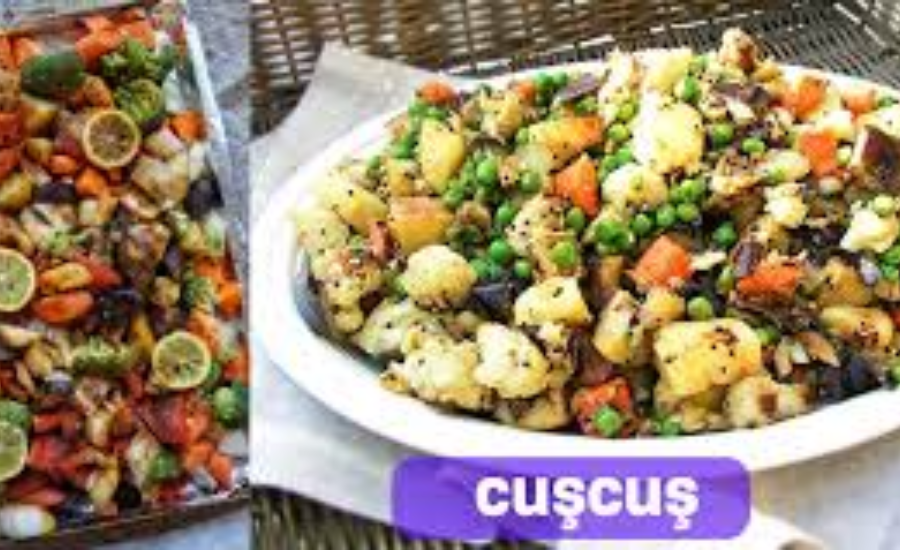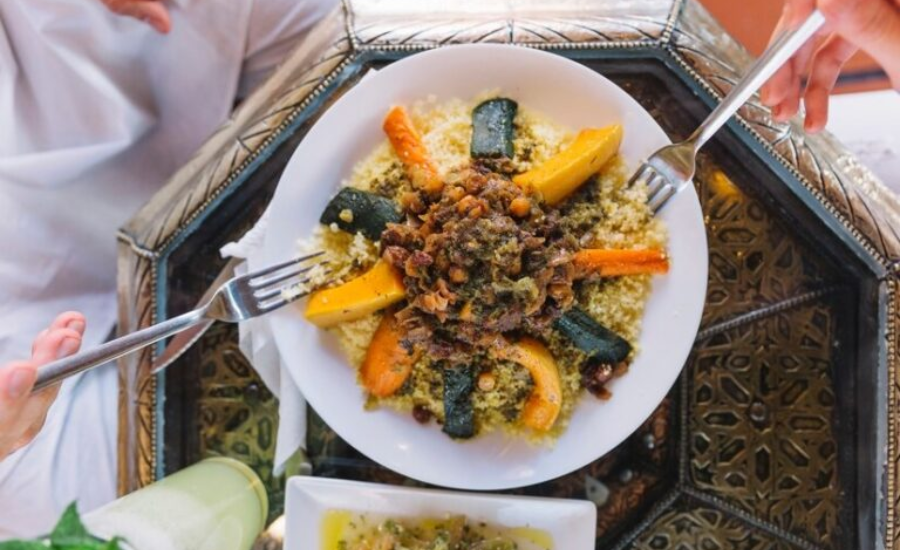The starting points of Cuşcuş are profoundly interwoven with the set of experiences and culture of the Berber public, native to the tremendous and different district of North Africa. This notorious dish, accepted to have been made between the eleventh and thirteenth hundreds of years, is something other than a culinary creation — it is an impression of the Berber lifestyle. In the dry scenes of the Maghreb, which incorporates Algeria, Morocco, and Tunisia, Cuşcuş turned into a dietary foundation, giving food and sustenance to ages.
The Starting Points of Cuşcuş

The name “Cuşcuş” is remembered from the Berber word “seksu,” which means “very much rolled” or “adjusted,” a fitting portrayal of the little, delicate grains that structure the foundation of this dish. Initially produced using millet, and later from semolina wheat, Cuşcuş was generally steamed over a stew, permitting the grains to retain the rich kinds of the meat and vegetables underneath. This strategy improved the taste as well as exemplified the creativity of the Berber public, taking full advantage of the fixings accessible in their current circumstance.
As the Berbers moved and exchanged with adjoining districts, Cuşcuş started to rise above its beginnings. The Fields assumed a critical part in acquainting this dish with Europe, where it was embraced and adjusted by different societies. Every district added its interesting touch, whether through the selection of flavors, the sort of meat utilized, or the strategy for readiness, transforming Cuşcuş into a flexible dish that could be customized to nearby preferences and fixings.
Today, Cuşcuş is commended around the world, for its brilliant surface and flavor as well as for its rich social legacy. Whether filled in as a basic, consoling feast or raised to a connoisseur delicacy, Cuşcuş keeps on enamoring palates and scaffolding culinary practices across landmasses.
Social Importance And Stylized Uses
Cuşcuş is significantly more than a staple dish in North African culture; it is an image of local area, custom, and festivity. Its importance rises above simple sustenance, implanting itself in the actual heart of social and formal practices across the area. In nations like Morocco, Algeria, and Tunisia, Cuşcuş is a focal point at social occasions that mark life’s most significant minutes — be it weddings, strict festivals, or family gatherings. The planning and sharing of Cuşcuş during these occasions is a custom that supports social bonds and mirrors the upsides of cordiality and liberality.
The demonstration of making Cuşcuş is much of the time a public undertaking, where relatives of any age meet up in the kitchen, each adding to the cycle
In numerous North African societies, serving Cuşcuş is something beyond giving a feast; it is an outflow of generosity and a token of welcome.T
Fixings And Fundamental Arrangement

At the core of Cuşcuş lies a basic yet flexible fixing: semolina wheat. This coarse wheat flour is blended in with water to shape little, grain-like particles that are the groundwork of the dish. Customarily, these grains are painstakingly steamed over a pot of stewing stew, permitting them to ingest the rich kinds of the stock underneath. The steaming system, frequently rehashed a few times, gives Cuşcuş its trademark light and feathery surface.A few locales use pearl millet, grain, or even cornmeal, each bestowing its novel flavor and surface to the dish.
The genuine magnificence of Cuşcuş lies in its flexibility. It fills in as a fresh start that can be changed to suit any dinner, whether exquisite or sweet. Generally, Cuşcuş is matched with a good stew produced using vegetables, meat, or fish, which fluctuates as per the season and the cook’s inclinations. The dish can likewise be redone with a variety of flavors, spices, and sauces, mirroring the rich culinary customs of the locale.
Various Sorts Of Cuşcuş
Cuşcuş is a dish with the ability to strike to adjust, prompting a wide assortment of local translations, each with its own particular flavors and readiness strategies. In Morocco, Cuşcuş is frequently celebrated with a seven-vegetable stew that incorporates fixings like carrots, zucchini, and chickpeas, making a dish that is however outwardly engaging as it very well might be fragrant. The expansion of flavors, for example, cumin and coriander further upgrade its flavor, making it a fragrant and bright highlight at any dinner.
Algeria offers an alternate interpretation of Cuşcuş, where the dish is regularly ready with delicate sheep or chicken.
In Tunisia, Cuşcuş takes on a bolder flavor profile, mirroring the nation’s affection for hot food. Tunisian Cuşcuş is frequently ready with harissa, a blazing stew glue that adds a particular kick to the dish. .
Wholesome Profile & MedicalAdvantages
Cuşcuş is considerably more than a flexible dish; it is likewise a nutritious expansion to any eating routine, offering a scope of medical advantages. As a decent wellspring of carbs, Cuşcuş gives the energy expected to get past everyday exercises. Its high fiber content advances solid processing and adds to a sensation of completion, which can be especially gainful for those hoping to deal with their weight.
Past its sugar and fiber content, Cuşcuş is plentiful in fundamental nutrients and minerals. For example, it contains selenium, a strong cell reinforcement that upholds invulnerable capability and safeguards against cell harm. Magnesium, one more key supplement found in Cuşcuş, plays an essential part in keeping up with bone well-being and supporting muscle capability. Furthermore, the B nutrients present in Cuşcuş assist with changing food into energy, supporting in general metabolic well-being. By integrating Cuşcuş into your dinners, you partake in a delectable dish as well as advantage from a balanced dietary profile that upholds by and large prosperity.
Cuşcuş In Contemporary Cooking

Its interesting skill to retain and supplement a wide cluster of flavors makes it a #1 among both expert culinary specialists and home cooks.
Contemporary cooks are pushing the limits of what Cuşcuş can be, exploring different avenues regarding inventive recipes that mix conventional readiness strategies with present-day flavors. For instance, a few culinary experts are integrating Cuşcuş into combination dishes that wed North African strategies with Asian impacts, making energizing new flavor blends. Others are investigating plant-based varieties, involving Cuşcuş as a material for exhibiting occasional vegetables and innovative dressings. fixing that rouses imagination and culinary articulation. Its persevering through prominence is a demonstration of its flexibility and immortal allure, guaranteeing that Cuşcuş stays a staple in both conventional and contemporary food.
Cooking Tips For Wonderful Cuşcuş
Making completely fleecy Cuşcuş is an expertise that can hoist your dish from great to outstanding. The critical lies in a couple of basic yet viable strategies. Begin by utilizing a huge, shallow bowl to equitably spread the grains. This permits the grains to consistently cook. As you set up the Cuşcuş, utilize your fingers or a fork to tenderly separate any bunches, guaranteeing that each grain cooks exclusively for a light and breezy surface.
With regards to steaming Cuşcuş, timing is everything. Be mindful so as not to overcook it, as this can prompt a thick, weighty surface. A spot of salt and a shower of excellent olive oil can unpretentiously improve the kind of the Cuşcuş, however, don’t hesitate for even a moment to try different things with various flavors and spices to fit the dish as you would prefer. Cuşcuş is a generous fixing, so let your innovativeness guide you as you investigate different flavor mixes.
Matching Cuşcuş With FlavorsFrom Around The World
One of the most thrilling parts of Cuşcuş is its inconceivable flexibility, making it an optimal ally to various worldwide foods. For a Center Eastern-propelled dish, think about serving Cuşcuş close by flavored sheep, supplemented by a cool and smooth tzatziki sauce. The rich, appetizing kinds of the sheep balanced brilliantly with the light, cushy Cuşcuş.
For the people who appreciate Asian food, Cuşcuş can assume another personality when joined with sautéed vegetables and soy-coated tofu. The outcome is a great mix of surfaces and flavors that unite the best-case scenario. No matter what your culinary inclinations, Cuşcuş has the flexibility to fulfill a great many preferences and desires.
Facilitating A Cuşcuş-Themed Supper Get-together
Start by laying the right foundation with a dynamic, North African-roused style. Rich tones, mind-boggling designs, and warm lighting can assist with making an enticing climate that establishes the vibe for the night.
With regards to the menu, offer an assortment of Cuşcuş dishes, each featuring different flavor profiles and fixings. Urge your visitors to blend and match dishes, investigating the vast conceivable outcomes Cuşcuş brings to the table. To upgrade the social experience, serve conventional drinks like reviving mint tea or a choice of Moroccan wines
One of the most engaging characteristics of Cuşcuş is its flexibility to different dietary necessities. For the people who need a without-gluten choice, consider utilizing options like cornmeal or without-gluten grains to make a base that is similarly essentially as fulfilling as customary Cuşcuş. Veggie lovers can appreciate Cuşcuş with a mixture of broiled vegetables, vegetables, and plant-based proteins, which is both nutritious and tasty to make a dish.
Indeed, even those following a low-carb diet can appreciate Cuşcuş with some restraint. By changing part sizes and matching it with a wealth of non-boring vegetables, you can make a fair feast that lines up with your dietary objectives.
Investigating Cuşcuş Past The Supper Table
Consider changing Cuşcuş into a consoling pastry by making a Cuşcuş pudding. Join cooked Cuşcuş with warm milk, honey, and a hint of cinnamon to make a comfortable, fulfilling sweet. For added surface and flavor, blend in dried natural products like apricots or raisins, and top with a small bunch of toasted nuts.
Cuşcuş can likewise be an astounding fixing in baking. Integrate it into cakes and cakes to add an interesting surface and flavor that separates your heated products. Explore different avenues regarding your number one recipes to find how Cuşcuş can improve your culinary manifestations, both sweet and flavorful. Whether as a sweet or a critical fix in a prepared treat, Cuşcuş demonstrates that its true capacity goes a long way past the supper table, offering vast open doors for culinary investigation.
Frequently Asked Questions (FAQs) About Cuşcuş
Q. What is Cuşcuş?
Known for its light, fluffy texture, it serves as a staple in countries such as Morocco, Algeria, and Tunisia
Q. How is Cuşcuş Generally Prepared?
The grains absorb the flavors from the stew, which often includes vegetables, meats, or fish, resulting in a flavorful and aromatic dish.
Q. What Are Some Regional Varieties of Cuşcuş?
There are several regional variations of Cuşcuş:
- Moroccan Cuşcuş: Typically served with a seven-vegetable stew.
- Algerian Cuşcuş: Often includes lamb or chicken, flavored with saffron and cinnamon.
- Tunisian Cuşcuş: Known for its bold, spicy flavors, often featuring harissa and seafood.
Q. Is Cuşcuş Nutritious?
Yes, Cuşcuş is nutritious. It is a good source of carbohydrates and fiber, which provide energy and support digestion. Cuşcuş also contains essential vitamins and minerals such as selenium, magnesium, and B vitamins, contributing to overall health.
Q. Can Cuşcuş Be Adapted for Special Dietary Needs?
Absolutely. Cuşcuş can be adapted to meet various dietary needs:
- Gluten-Free Diets: Alternatives like cornmeal or gluten-free grains can be used.
- Vegetarian: Cuşcuş can be enjoyed with roasted vegetables and legumes.
- Low-Carb Diets: Adjust portion sizes and pair with non-starchy vegetables.
Q. How Can I Integrate Cuşcuş into Modern Cuisine?
. It can serve as a base for salads, main courses, or even sweet dishes like pudding. Chefs are also experimenting with fusion cuisine, blending traditional Cuşcuş with global flavors to create innovative dishes.
Conclusion
Cuşcuş is something beyond a dish; a culinary diamond that has risen above its North African beginnings to turn into a cherished staple around the world. Its capacity to adjust to different flavors, fixings, and dietary requirements has established its place in both customary and current cooking. Whether you’re setting up a generous stew, facilitating a themed supper gathering, or investigating inventive pastry choices, Cuşcuş offers vast opportunities for culinary investigation. Its rich history, social importance, and flexibility make it an immortal dish that keeps on moving gourmet specialists and home cooks the same
Stay in touch for more updates and alters visit: Asseturi.Us!
